航太科技เทคโนโลยีอวกาศ
Taiwan Satellite Programs
National Space Organization (NSPO) was established in 1991 and is the sole institute that takes charge of the execution of the national space program and the development of space technology in Taiwan. NSPO have actively implemented to become the center of innovation and excellence for the space technology through the development of satellite programs. NSPO has built up the self-reliant space technology through the execution of FORMOSAT-5 and FORMOSAT-7 programs with the missions related to remote sensing and meteorology, respectively.
FORMOSAT Images Applications
National Space Organization (NSPO) NSPO provides satellite imagery and ground systems service of FORMOSAT-2 & FORMOSAT-5. We can use satellite image in application of Environmental Monitoring, such as the storage and pollution in water sources, reservoirs, and rivers in order to control the status of water resources supply.
The image can also provide for Agricultural Monitoring, Urban planning Strategy, Environmental impact assessment and natural resources monitoring.
The image can be used as the source for creating a map of 1/10,000 scale or for renewing the vector data. The most critical application of the satellite images is the Disaster Evaluation, such as Typhoon disaster, flood, landslide, volcanic eruptions, and etc.
數位科技เทคโนโลยีดิจิตอล
Smart Machine Shop - "Smart" Production in Transformation
Instrument Technology Research Center (ITRC) has 40-year history in optical manufacturing and inspection technology. Through machine smartization, traditional shops have transformed. By integrating with IC Technology, and transforming the framework of the traditional shops, ITRC turns the traditional machine shops into places more than just for production. With sensors, smart machines can instantly detect angular offsets, adopt modules to the production line for recording the process of machining and manufacturing, in order to collect and analyze the big data for smart applications. Smart machine can adjust angles and positions of workpiece, effectively monitor production quality, and predict the life expectancy of cutting tools and equipment requiring maintenance. All the measurement data can be uploaded to a cloud database. Integrating data capture and analysis capabilities, accessing to the database with various mobile devices, we can right away observe laboratories everywhere. The air conditioning and environmental monitoring systems are also optimized.
The machine shops of ITRC are demonstrated as the verification test sites. New industry visions start from a Smart Machine Shop!
iFlyover - Navigating Taiwan
Visualization Lab at National Center for High-performance Computing (NCHC) create this iFlyover platform to help users navigating through the 3D model of Taiwan. Users can upload their own data, including aerial photos and DTM data, and fly over their data set.
Visualization of the ADCP 3D f low field
A LabVIEW-based postprocessing tool for Sontek ADCP M9, acoustic Doppler current profiler river flow analyzer (ARFA), was developed to visualize the three-dimensional velocities obtained using the moving-boat method. The acoustic Doppler current profiler (ADCP) raw data along a track was projected to a decided straight line, sorted, transformed to the streamwise–spanwise coordinate system, interpolated to uniform grids, and output using visualization on a GUI interface and ASCII iles. The overall flow pattern and the secondary flow induced by the curving channel or by an obstacle can be described through our software. A compiled executive program that can be downloaded and installed on a personal computer was released.
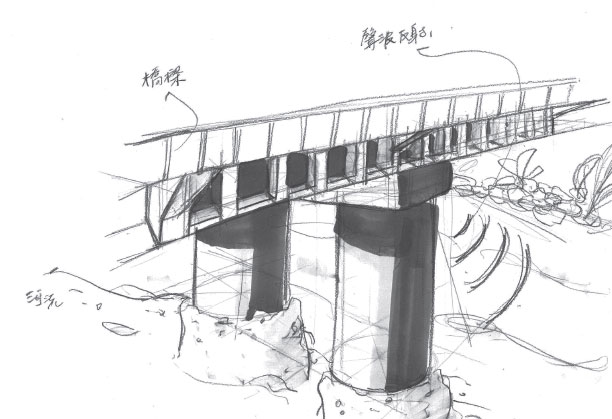
智慧城市เมืองอัจฉริยะ
Taiwania - The largest open supercomputer in Taiwan
National Center for High-performance Computing (NCHC) under the National Applied Research Laboratories (NARLabs) deployed a petascale supercomputer named “Taiwania”.
Taiwania is a supercomputer that offers an aggregate performance of over 1.7 PFLOPS. The system has a total 630 general compute nodes, 64 gpu accelerated compute nodes and 1 large memory compute node.
Taiwania is designed to support multiple field of applications, and most commercial packages can be installed, including physics, chemistry, mathematics, atmospheric, engineering and life sciences. The system also offers several compilers and MPI libraries for researchers to develop their own program.
More details, please see the website: https://www.nchc.org.tw/en/inner.php?CONTENT_ID=781
Ocean Bottom Seismograph
The Ocean Bottom Seismograph (OBS) has designed to record earth motion under oceans, such as the seismic waves caused by tectonic activities. OBSs deployments enable us to locate earthquakes and map the fault-geometry beneath the seafloor which are not well constrained by data recorded by land-based seismometers. However, there are lots of challenges (e.g. power consumption, size and weight, timing, unpredictable seabed environment) being faced to design a suitable OBS for the practical usage, so only a very small number of countries around the world are capable of manufacturing OBS.
Beginning from 2008, the ongoing OBS project has been leading by Taiwan Ocean Research Institute (TORI), Academic Sinica, and National Sun Yat-sen University from designing, testing to success. OBSs have been deployed and recovered in several research cruises and obtained the great results.
Taiwan-designed OBS units less expensive and weight (200 kilogram) than comparable foreign-made devices, not only long-term monitoring seismic activities but also anticipating to assess the potential hazards triggered by earthquakes and submarine volcanic activities.
Hybrid Earthquake Early Warning System
Hybrid Earthquake Early Warning System (EEWS) combined with the on-site EEWS of National Center for Research on Earthquake Engineering (NCREE) and the regional EEWS of the Central Weather Bureau, it provided a complete earthquake warning service. In the event of an earthquake, EEWS will raise alarm and estimate seismic magnitude before you feel the earthquake occur, remind you take refuge in any way quickly.
This system connects IoT and provides automate disaster prevention services. Including launches broadcasts, activates escape instructions, shuts off gas, controls elevators and guides evacuation. Whether it is used in schools, homes, offices, factories, hospitals, etc. This system provide service that personnel and belongings are safe, and avoid secondary damage. In the end, this system could reduce losses caused by the earthquake.
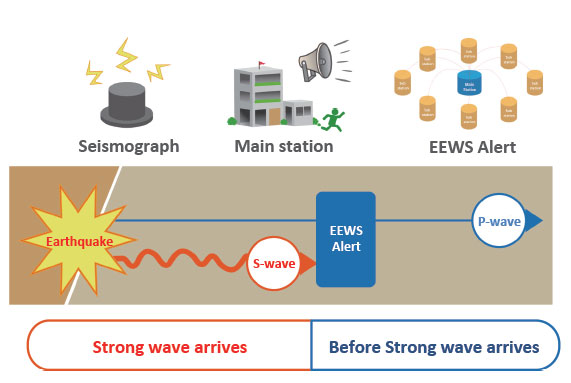
The Dayu cyber-physical technology
The Dayu cyber-physical technology integrates meteorological observation and forecasting information and supports multiple and advanced hydrological monitoring of the Internet of Things. Relevant monitoring data are stored to the server through seamless transmission technology, allowing information from different devices, machines and virtual systems to communicate with each other.
It can provide disaster-related information, and can automatically trigger prenegotiated active revention and reduction of disasters such as automatic opening or closing of gates, automatic opening of pumps, emergency drainage of sewers, evacuation, etc. Then, it can use the real-time and stable intelligent system for disaster analysis, and finally can integrate the decision support system with a comprehensive back-end service model to provide active mitigation measures.
Enclosed test field for self-driving
An Enclosed test field for self-driving will be opened in the coming 2019 in Tainan, Taiwan. The Enclosed test field will be equipped with the international certification standard and localization specialties. A more innovative business model will be designed for the test field to connect to the local and global industries.
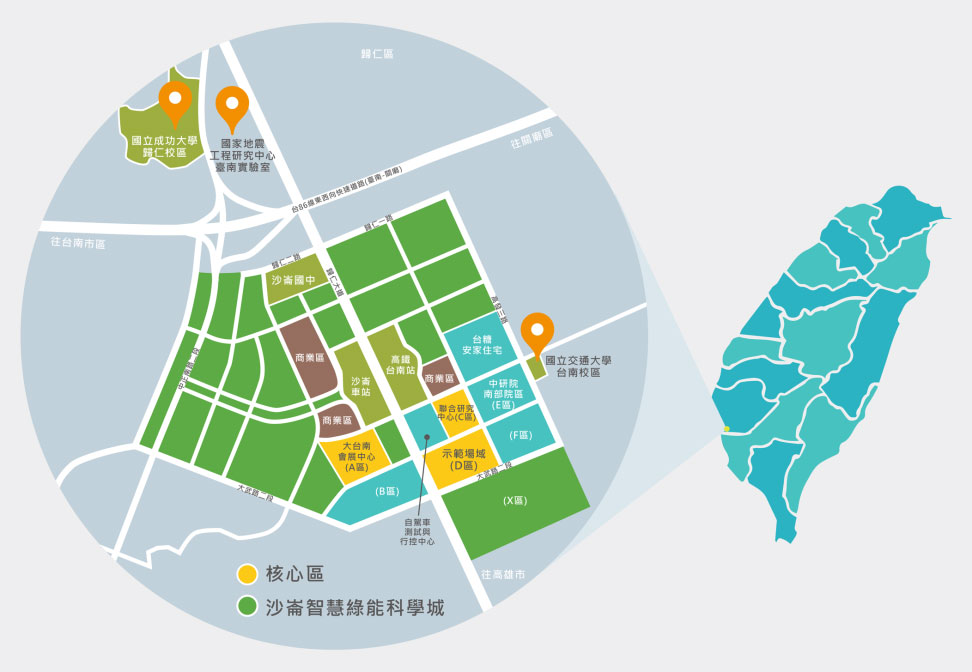
健康樂活สุขภาพและมีชีวิตอยู่
Bone structure analytic system – colored 3D imaging system
This invention provides a better system to present bone structure, executing operation process and presents distributed state of a bone structure parameter for diagnosis. The higher resolution and distinct images are reconstructed according to a grey scale image of skeleton captured by CT scanner. While the bone image is composed by pixels and each pixel includes luminance value relative to bone structure parameter, calculating the state of these parameters, we reconstruct and present these parameters with color coding images. This approach better display bone density that allows earlier and better diagnosis of osteoporosis and for monitoring fracture recovery or bone status before and after operation and treatments.
Smart Gas Sensor Chip
On July 31, 2014, a propylene gas explosion occurred in Kaohsiung, a city in southern Taiwan. The explosion overturned cars, destroyed roads, and sparked a massive inferno causing severe damage, including 32 deaths and 321 injuries.
This tragedy could have been prevented by installing smart gas sensors near the explosion site to detect the extensive leakage of high-risk volatile organic substances; however, gas sensors currently available on the market are large and can only be installed at fixed locations or be operated manually.
To prevent future explosions and protect people’s lives and properties, the National Nano Device Laboratories (NDL) of National Applied Research Laboratories (NARLabs) is developing smart gas sensor chips that can be directly installed in portable devices (e.g., smartphones or watches) to supplement fixed environmental sensors and vastly increase the sensing range. Smart sensor chips that can detect volatile organic compounds, carbon monoxide, carbon dioxide, and formaldehyde have already been successfully developed by NDL.
NARLabs Medical Device Alliance
In order to accelerate the pace of commoditization for Taiwan’s biotechnology medical device industry, National Applied Research Laboratories (NARLabs), on December 9 2014, established the “NARLabs Medical Device Alliance,” which is located at Instrument Technology Research Center (ITRC). The alliance is comprised of 20 members across government, industry, academia, and research institutions. It is the most comprehensive nationwide inter-departmental (MOST, MOEA, MOHW, and COA) support system. It offers resources from government, industry, academia, and research institutions. Startup teams’ products will be able to evolve from “innovations” to “valued creations”.
Equipped with laboratories for biological materials, electrical safety, biomedical circuits and systems, and 3D printing, NARLabs Medical Device Alliance provides R&D services in the field of high-end medical devices and comprehensive solutions for technical, validation, regulatory, and clinical requirements. The alliance aims to construct a strong innovation ecosystem to promote the commercialization of medical devices, and to build links to international partners so that Taiwan's industry in medical device manufacturing will be able to take advantage of new opportunities on the global markets.
To strengthen the competitive advantage of Taiwan's industry in biomedical grade 3D printing manufacturing, “NARLabs Medical Device Alliance" actively expands the industry value through chain integration. Facilitated by Instrument Technology Research Center of National Applied Research Laboratories, ThinTech Materials Technology Company (TTMC) has conducted a serises of certified biosafety tests and become the first Taiwanese manufacturer to pass preclinical animal trials for biomedical grade 3D printing metal powder. With the 3D printing equipment developed by Tongtai Machine & Tool Company, TTMC has printed metal medical products which have passed ISO 10993 biocompatibility testing.
人才培訓การฝึกอบรมความสามารถพิเศษ
International Training Program for Seismic Design of Structures
To assist countries in Asia-Pacific and Central and South America to improve their seismic design techniques, the National Center for Research on Earthquake Engineering have annually hosted the International Training Program for Seismic Design of Structures since 2002, thereby reinforcing the technology diplomacy of Taiwan. After the course was approved to become an official APEC event, participants actively signed up for the course. Therefore, this event has received the attention of various countries.
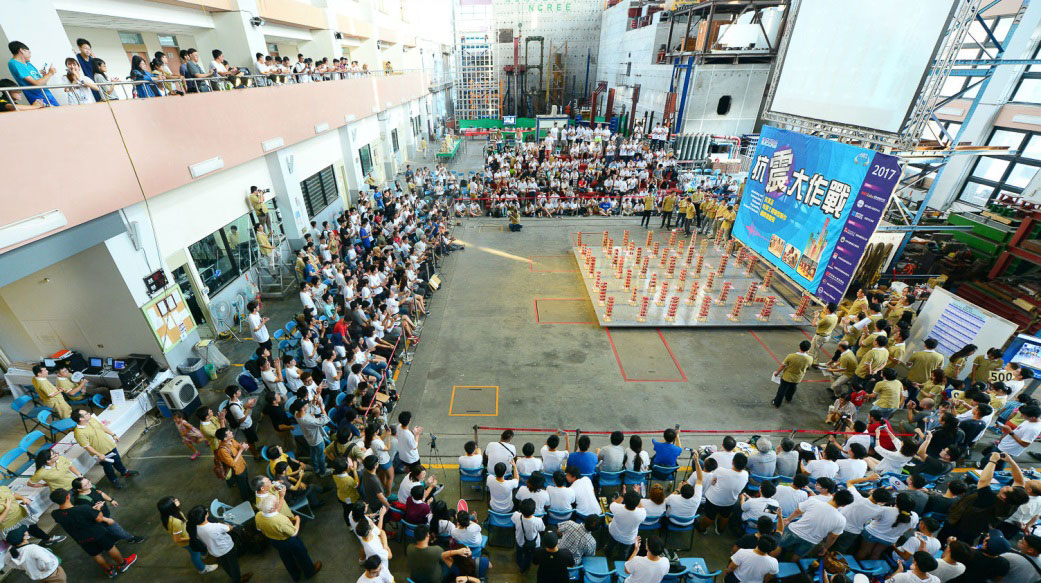
3D Printing Innovative Application Competition
Enhancing 3D printing technology in Taiwan, promoting diverse value-added applications The NCHC undertook a project of the Ministry of Science and Technology to host the 3D Printing Innovative Application Competition, which is aimed to cultivate talented individuals for 3D printing and to promote the linkage between technology research and development and industrial supply chains. This competition effectively facilitates the 3D printing application development in Taiwan.
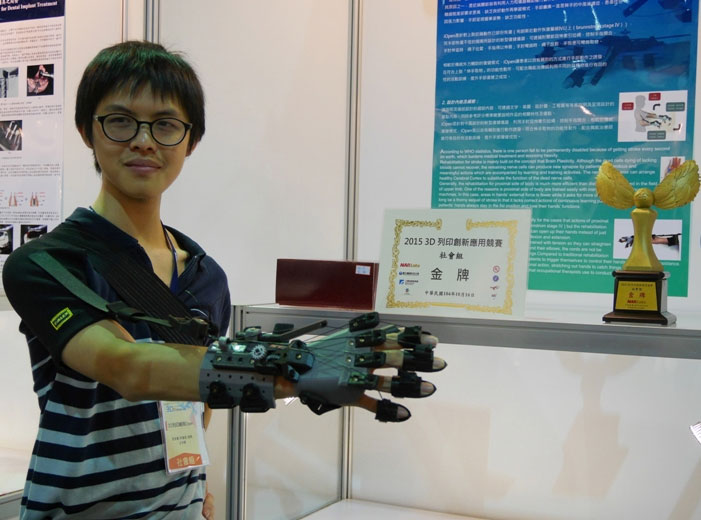
IC Design and Implementation Course Series
This course series was first offered in summer, 2015 and the content of which is divided into fullcustom and cell-based courses. In addition to regular classes, basic training courses including chip implementation, IC prototype fabrication, and chip testing were emphasized to assist the students in individually completing IC designs during their first project-based practical course, thereby effectively shortening the gap between industry and academia.

